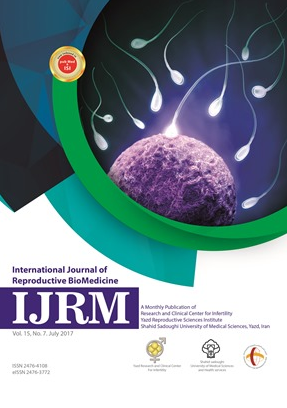
International Journal of Reproductive BioMedicine
ISSN: 2476-3772
The latest discoveries in all areas of reproduction and reproductive technology.
The effect of Coronavirus disease pandemic on maternal and neonatal health: A cohort study from Isfahan, Iran
Published date: Mar 09 2023
Journal Title: International Journal of Reproductive BioMedicine
Issue title: International Journal of Reproductive BioMedicine (IJRM): Volume 21, Issue No. 2
Pages: 159 - 166
Authors:
Abstract:
Background: The Coronavirus disease-2019 (COVID-19) pandemic may profoundly impact on maternal and neonatal health worldwide. However, a few studies have investigated this topic.
Objective: This study aimed to investigate the impact of the COVID-19 pandemic on maternal and neonatal health.
Materials and Methods: This retrospective cohort study analyzed collected data from March to May 2020, and the same period in 2019, involving 5711 pregnant women referring to comprehensive healthcare centers in Isfahan province health facilities, Iran. Pregnant women and neonates were followed-up until 40 days after the delivery. Demographic characteristics, pre-pregnancy, antenatal care, and postpregnancy variables were collected.
Results: A total of 5,711 pregnant women were studied, of whom 3477 (61%) were referred in 2019 (before the COVID-19 pandemic as nonexposed) and 2234 (39%) during the COVID-19 pandemic (as exposed group) in 2020. For those living in cities with a population of > 20,000, the number of antenatal care were lower about 2% compared to nonexposed group (p = 0.01). The number of mothers with a history of the underlying disease who referred to a comprehensive healthcare center during the COVID-19 pandemic (47%) was lower about 6% compared to nonexposed group (41%) (p < 0.001). During the COVID-19 pandemic, the prevalence of hypertension and gestational diabetes mellitus was 5% (n = 109) and 20% (n = 445), which were higher about 2% and 4%, respectively, compared to nonexposed group. The COVID-19 pandemic had no other significant effect on mothers’ and neonates’ other characteristics than nonexposed group.
Conclusion: The COVID-19 pandemic imposes no significant effect on mothers’ and neonates’ health compared to nonexposed group.
Key words: Maternal health, Neonatal health, Pregnancy, COVID-19.
References:
[1] Zhu H, Wei L, Niu P. The novel coronavirus outbreak in Wuhan, China. Glob Health Res Policy 2020; 5: 6.
[2] Hellowell M, Myburgh A, Sjoblom M, Gurazada S, Clarke D. How COVID-19 (coronavirus) affects private health care providers in developing countries. Available at: https://blogs worldbank org/health/how-covid- 19-coronavirus-affects-private-health-care-providersdeveloping- countries.
[3] Kutsar D, Kurvet-Kaosaar L. The impact of the COVID-19 pandemic on families: Young people’s experiences in Estonia. Front Sociol 2021; 6: 732984.
[4] Shadmi E, Chen Y, Dourado I, Faran-Perach I, Furler J, Hangoma P, et al. Health equity and COVID-19: Global perspectives. Int J Equity Health 2020; 19: 104.
[5] Muralidar S, Ambi SV, Sekaran S, Krishnan UM. The emergence of COVID-19 as a global pandemic: Understanding the epidemiology, immune response and potential therapeutic targets of SARS-CoV-2. Biochimie 2020; 179: 85–100.
[6] World Health Organization. Pulse survey on continuity of essential health services during the COVID-19 pandemic: Interim report, 27 August 2020. Available at: https://www.who.int/publications/i/item/who-2019- nCoV-EHS_Continuity-survey-2020-1.
[7] Chmielewska B, Barratt I, Townsend R, Kalafat E, van der Meulen J, Gurol-Urganci I, et al. Effects of the COVID- 19 pandemic on maternal and perinatal outcomes: A systematic review and meta-analysis. Lancet Glob Health 2021; 9: e759–e772.
[8] Ministry of Health, Treatment and Medical Education of Iran. [Iranian National Program on Safe Motherhood, Integrated Care on Mother’s Health, Outside hospital services Guide]. Iran: Ministry of Health, Treatment and Medical Education of Iran; 2021. (in Persian)
[9] Ranjbar F, Allahqoli L, Ahmadi S, Mousavi R, Gharacheh M, Eshraghi N, et al. Changes in pregnancy outcomes during the COVID-19 lockdown in Iran. BMC Pregnancy Childbirth 2021; 21: 577.
[10] Mor M, Kugler N, Jauniaux E, Betser M, Wiener Y, Cuckle H, et al. Impact of the COVID-19 pandemic on excess perinatal mortality and morbidity in Israel. Am J Perinatol 2021; 38: 398–403.
[11] Pasternak B, Neovius M, Söderling J, Ahlberg M, Norman M, Ludvigsson JF, et al. Preterm birth and stillbirth during the COVID-19 pandemic in Sweden: A nationwide cohort study. Ann Intern Med 2021; 174: 873–875.
[12] Okeke EN, Abubakar IS, De Guttry R. Stillbirths and newborn deaths increased during the COVID-19 pandemic in Nigeria. Health Aff 2021; 40: 1797–1805.
[13] Khalil A, Von Dadelszen P, Draycott T, Ugwumadu A, O’Brien P, Magee L. Change in the incidence of stillbirth and preterm delivery during the COVID-19 pandemic. JAMA 2020; 324: 705–706.
[14] Simpson AN, Snelgrove JW, Sutradhar R, Everett K, Liu N, Baxter NN. Perinatal outcomes during the COVID-19 pandemic in Ontario, Canada. JAMA Netw Open 2021; 4: e2110104.
[15] Deli T, Lampe R, Juhasz AG, Kovacs T, Darago P, Bacsko G, et al. [How the cesarean delivery rate decreased at the Department of Obstetrics and Gynecology, University of Debrecen during the COVID-19 pandemic]. Orv Hetil 2021; 162: 811–823. (in Hungrian)
[16] Sun SY, Guazzelli CAF, de Morais LR, Dittmer FP, Augusto MN, Soares AC, et al. Effect of delayed obstetric labor care during the COVID-19 pandemic on perinatal outcomes. Int J Gynecol Obstet 2020; 151: 287–289.
[17] Goyal M, Singh P, Singh K, Shekhar S, Agrawal N, Misra S. The effect of the COVID-19 pandemic on maternal health due to delay in seeking health care: Experience from a tertiary center. Int J Gynecol Obstet 2021; 152: 231–235.
[18] Boelig RC, Manuck T, Oliver EA, Di Mascio D, Saccone G, Bellussi F, et al. Labor and delivery guidance for COVID-19. Am J Obstet Gynecol MFM 2020; 2 (Suppl.): 100110.